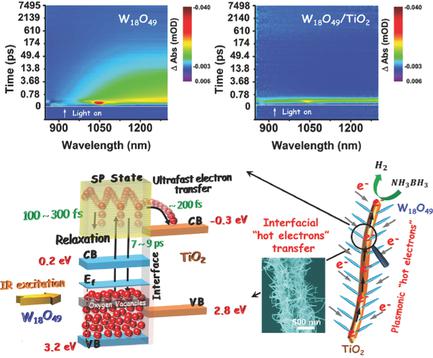当前位置:
X-MOL 学术
›
Adv. Mater.
›
论文详情
Our official English website, www.x-mol.net, welcomes your
feedback! (Note: you will need to create a separate account there.)
IR‐Driven Ultrafast Transfer of Plasmonic Hot Electrons in Nonmetallic Branched Heterostructures for Enhanced H2 Generation
Advanced Materials ( IF 27.4 ) Pub Date : 2018-01-12 , DOI: 10.1002/adma.201705221 Zhenyi Zhang 1 , Xiaoyi Jiang 1 , Benkang Liu 1 , Lijiao Guo 1 , Na Lu 1 , Li Wang 1 , Jindou Huang 1 , Kuichao Liu 1 , Bin Dong 1
Advanced Materials ( IF 27.4 ) Pub Date : 2018-01-12 , DOI: 10.1002/adma.201705221 Zhenyi Zhang 1 , Xiaoyi Jiang 1 , Benkang Liu 1 , Lijiao Guo 1 , Na Lu 1 , Li Wang 1 , Jindou Huang 1 , Kuichao Liu 1 , Bin Dong 1
Affiliation

|
The ultrafast transfer of plasmon‐induced hot electrons is considered an effective kinetics process to enhance the photoconversion efficiencies of semiconductors through strong localized surface plasmon resonance (LSPR) of plasmonic nanostructures. Although this classical sensitization approach is widely used in noble‐metal–semiconductor systems, it remains unclear in nonmetallic plasmonic heterostructures. Here, by combining ultrafast transient absorption spectroscopy with theoretical simulations, IR‐driven transfer of plasmon‐induced hot electron in a nonmetallic branched heterostructure is demonstrated, which is fabricated through solvothermal growth of plasmonic W18O49 nanowires (as branches) onto TiO2 electrospun nanofibers (as backbones). The ultrafast transfer of hot electron from the W18O49 branches to the TiO2 backbones occurs within a timeframe on the order of 200 fs with very large rate constants ranging from 3.8 × 1012 to 5.5 × 1012 s−1. Upon LSPR excitation by low‐energy IR photons, the W18O49/TiO2 branched heterostructure exhibits obviously enhanced catalytic H2 generation from ammonia borane compared with that of W18O49 nanowires. Further investigations by finely controlling experimental conditions unambiguously confirm that this plasmon‐enhanced catalytic activity arises from the transfer of hot electron rather than from the photothermal effect.
中文翻译:

红外驱动的等离子体热电子在非金属分支异质结构中的超快转移,以增强氢气的产生
等离子体激元引起的热电子的超快转移被认为是通过等离子体纳米结构的强局部表面等离子体共振(LSPR)来增强半导体的光转换效率的有效动力学过程。尽管这种经典的敏化方法已广泛用于贵金属-半导体系统中,但在非金属等离激元异质结构中仍不清楚。在此,通过将超快速瞬态吸收光谱与理论模拟相结合,证明了等离子体驱动的热电子在非金属分支异质结构中的红外驱动转移,这是通过等离子W 18 O 49纳米线(作为分支)溶剂热生长到TiO 2上而制成的电纺纳米纤维(作为骨架)。热电子从W 18 O 49分支到TiO 2主链的超快转移发生在一个200 fs量级的时间范围内,并且速率常数非常大,范围为3.8×10 12到5.5×10 12 s -1。与低能红外光子激发LSPR相比,W 18 O 49 / TiO 2支链异质结构与W 18 O 49相比,氨硼烷的催化H 2生成明显增强。纳米线。通过精确控制实验条件的进一步研究明确证实,这种等离激元增强的催化活性是由于热电子的转移而不是由于光热效应而产生的。
更新日期:2018-01-12
中文翻译:

红外驱动的等离子体热电子在非金属分支异质结构中的超快转移,以增强氢气的产生
等离子体激元引起的热电子的超快转移被认为是通过等离子体纳米结构的强局部表面等离子体共振(LSPR)来增强半导体的光转换效率的有效动力学过程。尽管这种经典的敏化方法已广泛用于贵金属-半导体系统中,但在非金属等离激元异质结构中仍不清楚。在此,通过将超快速瞬态吸收光谱与理论模拟相结合,证明了等离子体驱动的热电子在非金属分支异质结构中的红外驱动转移,这是通过等离子W 18 O 49纳米线(作为分支)溶剂热生长到TiO 2上而制成的电纺纳米纤维(作为骨架)。热电子从W 18 O 49分支到TiO 2主链的超快转移发生在一个200 fs量级的时间范围内,并且速率常数非常大,范围为3.8×10 12到5.5×10 12 s -1。与低能红外光子激发LSPR相比,W 18 O 49 / TiO 2支链异质结构与W 18 O 49相比,氨硼烷的催化H 2生成明显增强。纳米线。通过精确控制实验条件的进一步研究明确证实,这种等离激元增强的催化活性是由于热电子的转移而不是由于光热效应而产生的。











































 京公网安备 11010802027423号
京公网安备 11010802027423号